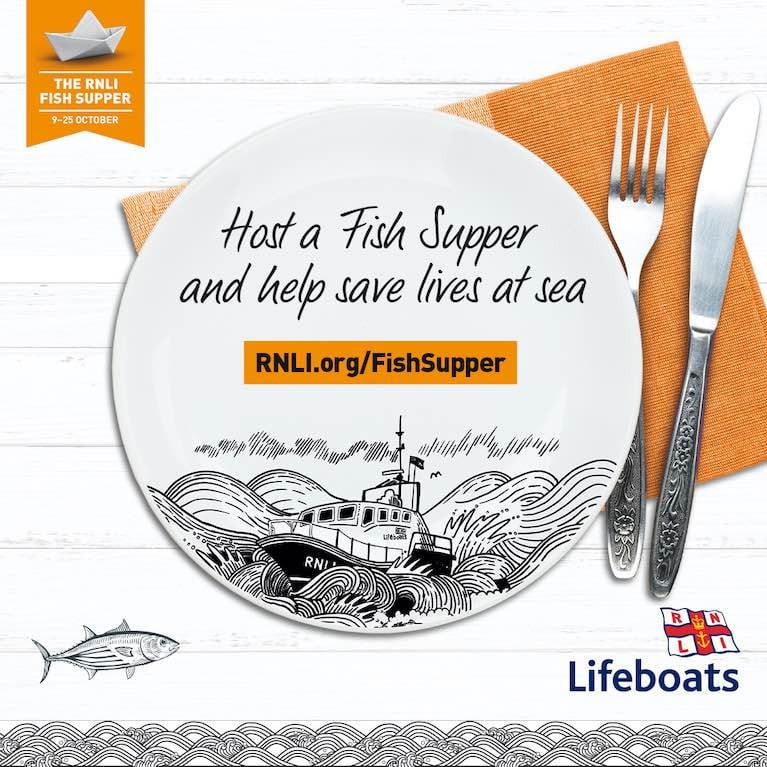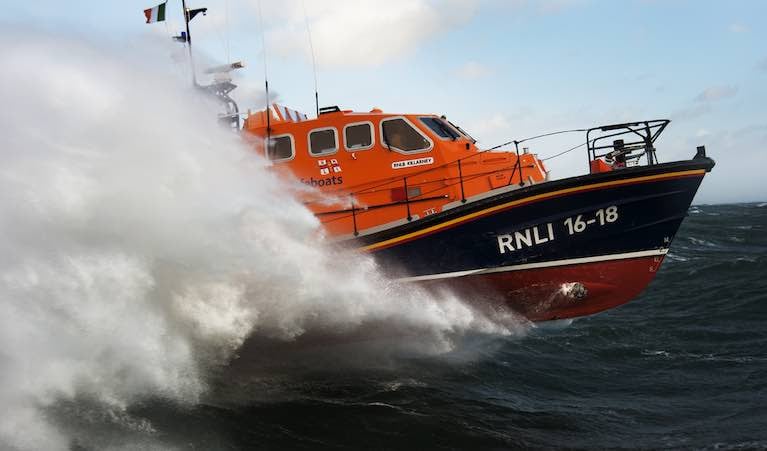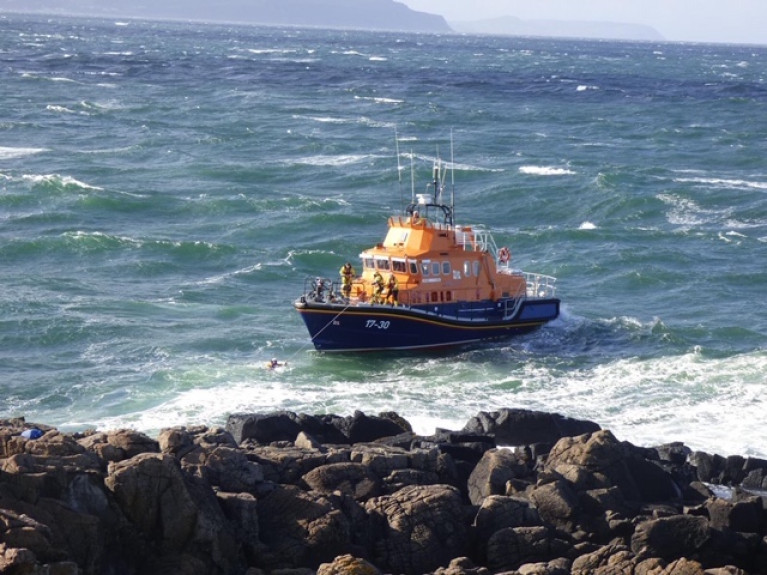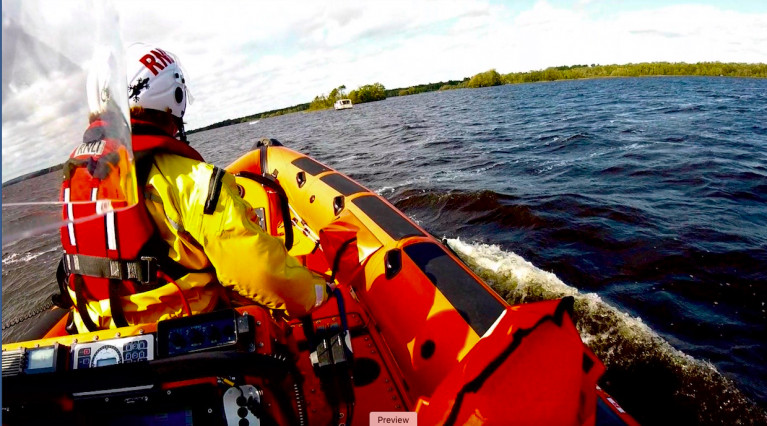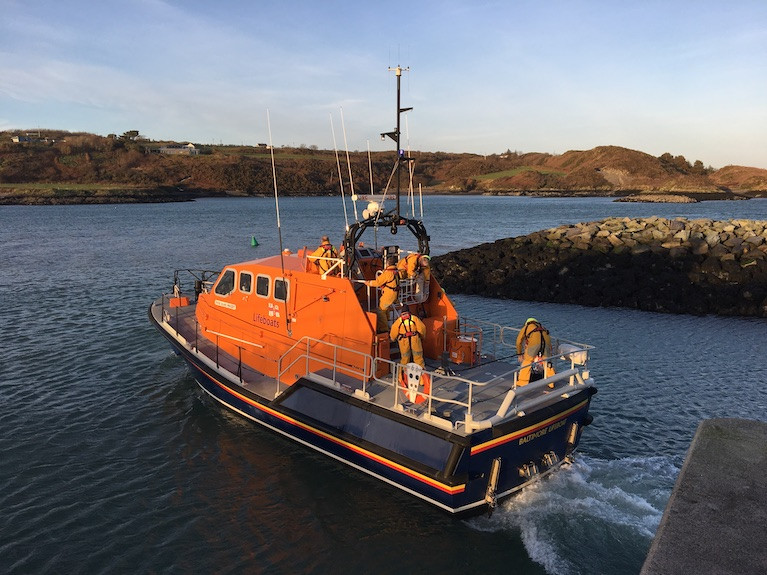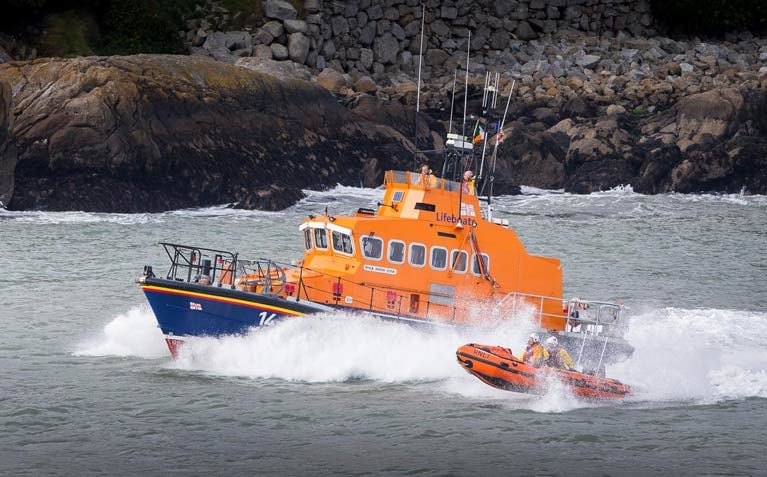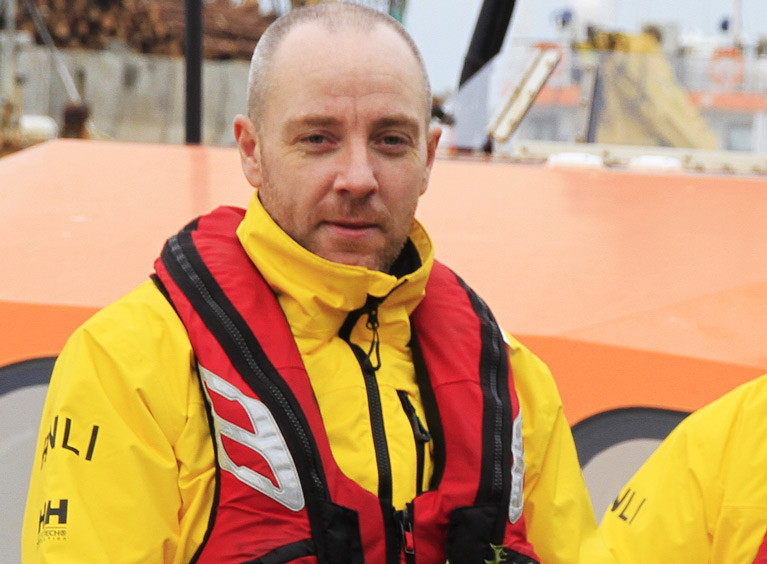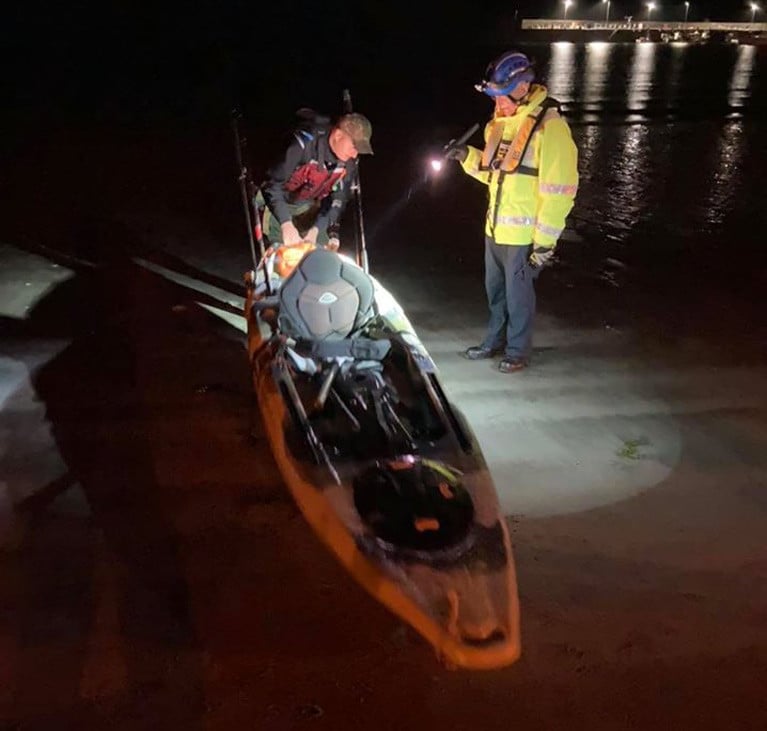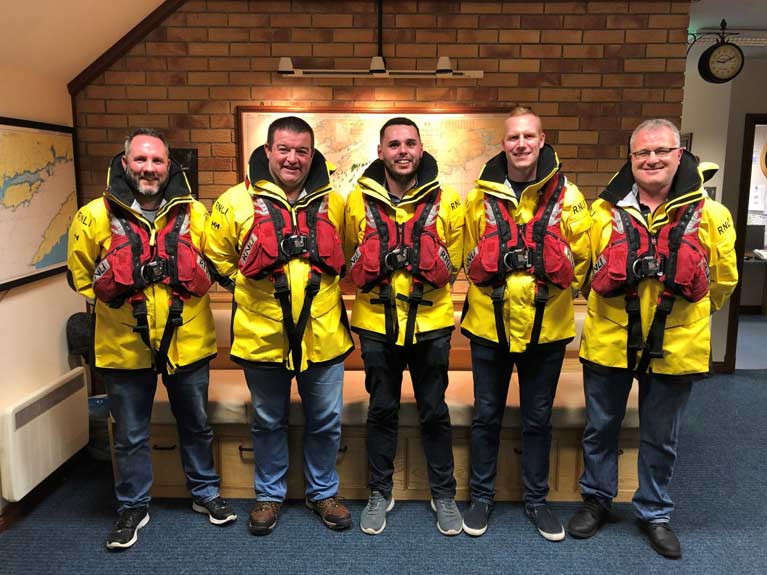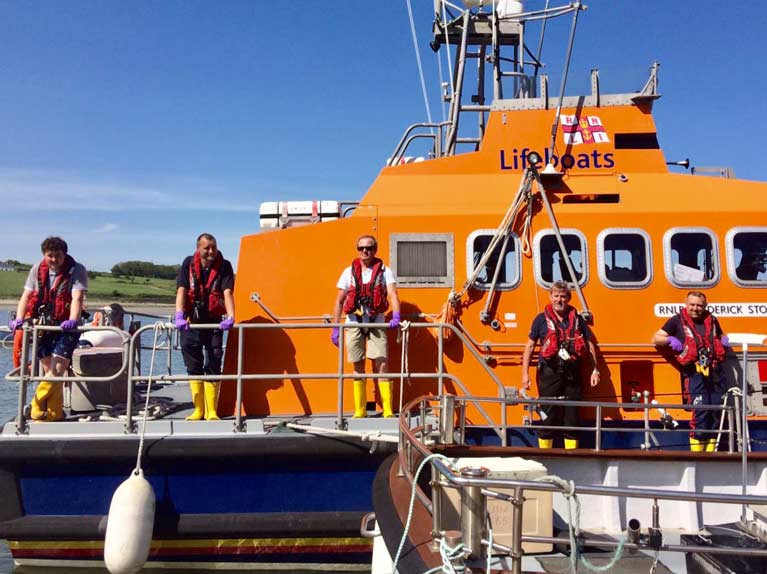Displaying items by tag: Lifeboat
Derry Clarke Does Scallops for the RNLI: Host a Fish Supper & Help the RNLI Save Lives This Autumn
Lifesavers at the RNLI are encouraging people to support them by signing up to host a Fish Supper this October or donate the price of fish and chips to raise vital funds for the lifesaving charity.
The RNLI's annual fishy fundraiser encourages people to host a Fish Supper during the month of October with donations being made in support of the lifesaving charity or if they prefer, to donate the price of a fish and chip supper.
With restrictions in place due to the Coronavirus pandemic, this year's Fish Supper event is a bit different. Therefore, the RNLI is encouraging people to host their Fish Supper online this year, if they can't have it with their household. Of course, if people prefer, they can always donate the price of a fish and chip supper online.
With the Coronavirus pandemic having a huge impact on the RNLI's ability to generate income, fundraising events like Fish Supper are more important than ever.
To give people some ideas, award-winning chef Derry Clarke, of L'Ecrivain restaurant has generously shared some of his favourite fish recipes and even accompanied them with a specially recorded video. Derry and Sallyanne Clarke are huge supporters of the work of the RNLI and Derry even wore his lifeboats t-shirt in the video.
Scallops
Mussels
The charity's lifeboat crews have faced an incredibly busy summer as people flocked to the coast and inland waters when restrictions eased. To sign up to host your own Fish Supper, and to find a load of fantastic recipes from some top celebrity chefs, visit: RNLI.org/Fish
Family Whose Great-Grandfather was Recognised for Lifesaving Rescue Pay Tribute to Kilmore Quay RNLI
A Wexford family has expressed thanks to the volunteers of Kilmore Quay RNLI who brought them to safety earlier this summer when their pleasure craft got into difficulty.
James Kehoe and his grandchildren Aisling, 13, Emily, 9, and Orla, 7, were rescued when their 7m boat broke down having sustained engine failure in Ballyteigue Bay, half a mile north west of Forlorn Point in county Wexford. The lifeboat under Coxswain Aidan Bates, went to the family’s aid and towed the vessel safely back to Kilmore Quay.
Such was seven-year-old Orla’s delight at being rescued by the lifeboat, she has since created a scrapbook about her adventure.
 Emily, Aisling and Orla
Emily, Aisling and Orla
It also transpires that the family have a close RNLI connection with James’ late father and the girls’ great grandfather, Jimmy Kehoe, a former station mechanic who was awarded a Thanks of the Institution Inscribed on Vellum, by the RNLI, for his part in a dangerous rescue off the Saltee Islands 63 years ago.
Jimmy was one of seven crew members on the Kilmore Quay lifeboat Ann Isabella Pyemont, which successfully rescued 10 seamen from the ill-stricken French trawler Augusta Mariste, in a fresh south to southwesterly gale with gusts at times of Force 10, in Ballyteigue Bay on the 19 December 1957.
Kilmore Quay RNLI Coxswain Aidan Bates said: ‘We were delighted to be able to help the family during the summer and tow the vessel back to safety. It was lovely to hear that Orla went to such efforts to create a scrapbook about the rescue and to be reminded of the girls' great-grandfather Jimmy, one of seven former Kilmore Quay RNLI volunteers who were deservedly recognised for their selfless bravery and courage all those years ago.’
 Orla
Orla
James Kehoe, skipper of the boat and the girls’ grandfather said: ‘It was good to experience the professionalism of the lifeboat crew through the eyes of my seven-year-old granddaughter Orla who took such a personal interest in the operation from start to finish.
‘When at sea with small children and the unexpected happens, it is so important to do the right thing. A good ship to shore communications system enabled me to contact Rosslare Coast Guard Radio – which is manned 24/7 – give my exact position and explain the situation. There is an instant response and the system works flawlessly.
‘Kilmore Quay RNLI has a proud history going back several generations. The current incredibly powerful all-weather boat is state of the art in terms of nautical sophistication. We always need to bear in mind that the service is manned by men and women who volunteer as crew members and who are prepared to take to the sea on a rescue mission in the most appalling weather conditions. Nothing will deter them in a real-life threatening emergency.
‘It is so important to remember that this incredible service is funded by voluntary donations. This year Covid-19 has meant the cancellation of the annual Lifeboat Day which is a significant fundraising event for the RNLI so next time you see that lifeboat box on a shop counter – be generous.’
Portrush RNLI Lifeboat Rescue Teenage Boy in Difficulty off Portstewart Head (Video)
Portrush RNLI has rescued a teenage boy who got into difficulty while jumping into the sea off rocks at Portstewart Head yesterday afternoon.
The volunteer crew were requested to launch their all-weather lifeboat by Belfast Coastguard at 2.42 pm following an initial request to go to the aid of someone in distress off Downhill Beach which subsequently transpired to be a false alarm with good intent. However, once on board, the lifeboat crew were alerted by the Coastguard to a separate incident after a 999 call was made by a member of the public to say a person was in difficulty in the water off Portstewart Head, some five nautical miles from Portrush.
The lifeboat launched under Coxswain Des Austin and with six crew members onboard and made its way to the scene arriving in less than 10 minutes.
Weather conditions at the time were challenging with a Force 6-7 north to northwest wind, some showers, and a rough sea with 2-3m swells. Visibility was good.
As the lifeboat approached the scene, the crew observed a person in the water waving their arms. A teenage boy who was wearing a wetsuit was struggling against an ebbing tide which was pulling him away from the land and out to sea off the west side of Portstewart Head.
The Coxswain manoeuvred the lifeboat close to where the casualty was in the surf and breaking waves while the station’s mechanic donned a dry suit and PPE. A line was then attached to the mechanic who jumped into the water and grabbed the casualty to safety. The remainder of the crew pulled the mechanic and casualty around to the starboard side of the lifeboat as the Coxswain manoeuvred into position.
 A line was then attached to the lifeboat mechanic who jumped into the water and grabbed the casualty to safety
A line was then attached to the lifeboat mechanic who jumped into the water and grabbed the casualty to safety
The lifeboat crew administered casualty care to make the boy who was showing signs of hypothermia and exhaustion and was suffering from the effects of shock, comfortable, as the lifeboat made its way back to Portrush Harbour. He was then transferred into the care of Coleraine Coastguard and the Northern Ireland Ambulance Service.
Speaking following the call out, Portrush RNLI Coxswain Des Austin said: ‘Conditions were challenging at sea today and time was of the essence. The tide was turning at the time the casualty got into difficulty and the conditions were pulling him out to sea.
The prompt actions of the lifeboat crew saved a life and we would like to wish the casualty well following his ordeal.
‘We would remind anyone planning an activity at sea to always respect the water. Always be prepared, always have the right clothing and safety equipment including a lifejacket or buoyancy aid. Conditions at sea can change quickly and it is important to understand how that affects the area of coastline.
Should you get into difficulty or see someone in trouble, dial 999 or 112 and ask for the Coastguard.’
Two Callouts for Lough Derg RNLI Including a Vessel Taking on Water in Rough Weather
Two callouts for Lough Derg RNLI today – the first to two people on a 32ft cruiser aground by the Silver Islands on the Galway shore at the northern end of Lough Derg, and shortly after, a Mayday call to four people on board a 16ft motorboat taking on water in rough weather south of Parker’s Point on the southwestern end of the lake.
At 1.06 pm this afternoon, Sunday, September 13, Valentia Coast Guard requested Lough Derg RNLI lifeboat Jean Spier to assist 2 people on a 32ft cruiser reported to be aground by the Silver Islands, inside the red marker ‘Juliet’.
At 1.20 pm the lifeboat launched with helm Eleanor Hooker and crew Steve Smyth, Doireann Kennedy and Chris Parker on board. Visibility was good, and the wind was southwesterly Force 4, gusting Force 5.
As the lifeboat approached Cloondavaun Bay, the volunteer crew could see three vessels on standby in safe water monitoring the casualty vessel.
The lifeboat boat rounded the red navigation mark ‘Juliet’ and, as the water level on the lake is currently lower than usual, navigated a slow, safe route to the casualty vessel.
The lifeboat was alongside the casualty vessel at 1.46 pm. Both people on board were safe and unharmed and wearing their lifejackets. An RNLI volunteer transferred to the casualty vessel. Once he was satisfied that the vessel was not holed, he set up for a tow.
At 1.59 pm the lifeboat had the cruiser off the rocks and towed out into safe water where drives and rudder were checked and found to be in good working order.
The lifeboat took their crew member back onto the lifeboat and the cruiser made it’s way safely to Cloondavaun Bay Harbour
The lifeboat departed the scene and was back at station at 2.25 pm.
At 4.30 pm Valentia Coast Guard requested Lough Derg RNLI to assist 4 people on a 16ft motorboat taking on water in rough weather, and in danger of sinking. At 4.40 pm Lough Derg RNLI launched with helm Eleanor Hooker and crew Ger Egan, Doireann Kennedy and Tom Hayes on board. Winds were southwesterly, Force 5 with a moderate chop.
Given the critical nature of the launch, Rescue 115, the Irish Coast Guard Search and Rescue Helicopter took off from their base at Shannon Airport and Killaloe Coast Guard also launched from their base in Killaloe.
As the lifeboat approached Parker’s Point, Rescue 115 hailed the lifeboat to say they had located the casualty vessel and were going to hover close by. At 4.56 pm the lifeboat was alongside the casualty vessel. All four persons were unharmed and wearing their lifejackets. The had deployed their anchor which was holding them off the rocky shore.
Due to the swell swamping their deck, the casualty vessel had taken on a significant amount of water, which the crew were bailing from the bilge. At this time Killaloe Coast Guard arrived on scene and as the casualty vessel’s base was at Killaloe, it was agreed with Valentia Coast Guard that Killaloe Coast Guard would take the casualty vessel back to Killaloe.
Rescue 115 departed the scene to return to its base at Shannon. Lough Derg RNLI departed the scene was back at Station in Dromineer at 5.20 pm.
Peter Kennedy, Deputy Launching Authority at Lough Derg RNLI praised all the RNLI volunteers for their ‘swift response to the callout. Four people were reported to be in grave and imminent danger, and the efficient shore crew assistance was particularly crucial to a speedy launch of the lifeboat under these circumstances.’
Baltimore RNLI was called out to provide a medical evacuation this afternoon from Sherkin Island off the coast of Baltimore, West Cork.
The volunteer lifeboat crew, under Coxswain Kieran Cotter, launched their all-weather lifeboat at 3.06 pm, following a request from the Irish Coast Guard to provide medical assistance and evacuation to a woman who had sustained an injury following a fall.
The Baltimore all-weather lifeboat crew arrived at Sherkin Island pier at 3.15 pm and reached the casualty at the same time as a First Responder team who were also in the area. An initial assessment was carried out by one of the First Responders and then the voluntary lifeboat crew, assisted by the First Responder team, transferred the casualty onboard the lifeboat.
The lifeboat then returned to the station in Baltimore and the casualty was handed over to the care of HSE Ambulance crew at 4.30 pm.
Conditions at sea during the call out were calm with a south - south-westerly force 3-4 wind, no sea swell and good visibility.
Speaking following the call out, Kate Callanan, Baltimore RNLI Volunteer Lifeboat Press Officer said: ‘If you find yourself in a medical emergency whilst on an island call 999 or 112 and explain to the operator what the nature of the call is. The operator will then make sure that the call is directed to both the Coast Guard and the National Ambulance Service. We would like to thank the First Responders for assisting in this call and we wish the casualty a speedy recovery.’
Dun Laoghaire Harbour RNLI Lifeboats Rescue Two People after Jet Skis Suffer Engine Problems
At 9:11 pm last night (Friday 24 July), Dublin Coast Guard requested Dun Laoghaire Harbour RNLI to assist two people on separate jet skis which had engine issues just off the North Bull wall in Dublin Bay.
The all-weather lifeboat was launched at 9:20 pm under Coxswain Stuart Kane with five crew on board and made its way to the scene arriving at 09:35 pm. The all-weather lifeboat crew assessed the situation on arrival and saw that the two jet skis had drifted north towards Bull Wall and into shallower water which was out of the all-weather lifeboats reach. The crew swiftly made a decision and requested the help from the stations smaller inshore lifeboat “Realt Na Mara” which was launched at 09:55 pm.
Arriving on scene at 10:10 pm the inshore lifeboat took the two vessels in tow, after nearly two hours at sea the two lifeboats arrived back in Dun Laoghaire Harbour at 23:20 pm.
Weather conditions at the time were described as good with a slight wind and good visibility.
Speaking following the call out, Liam Mullan, Dun Laoghaire RNLI Lifeboat Press Officer said: ‘ The volunteer crew’s involved were happy to have located the two people quickly last night with light fading fast in an area with a lot of shipping traffic and return them to shore safely. It's important to remind everyone to make sure that their vessel engines are thoroughly checked regulatory by a professional before taking to the water and always have a suitable means of communication to call the Irish Coast Guard for help.’
RNLI Volunteer Peter Byrne participated in his first callout as Wicklow all-weather lifeboat launched shortly after 10:05 pm on Wednesday night (15 July), after a member of the public reported seeing a windsurfer having problems getting ashore near Brittas Bay beach as darkness fell.
As the lifeboat proceeded south to the last known reported position, more information was relayed from the Coast Guard and it was confirmed that the craft was, in fact, a trimaran.
The lifeboat was on scene at 10:23 pm and began a search, conditions in the area were calm with good visibility. At 10:35 pm contact was made with a solo sailor on a 16-foot trimaran near Potter’s Point. He had secured his boat on the beach and was waiting for the tide to turn before resuming passage north and no assistance was required.
Once Coxswain Nick Keogh was satisfied the sailor required no further assistance, the lifeboat was stood down by the Coast Guard and returned to station.
Following the call out, Wicklow RNLI Press Officer Tommy Dover said: ‘We would like to commend the vigilant member of the public who contacted the Coast Guard, fortunately, the sailor did not require assistance.’
The crew on the callout were Coxswain Nick Keogh, Mechanic Brendan Copeland, Tommy MacAulay, Graham Fitzgerald, Connie ‘O Gara and Peter Byrne.
Call Outs for Bangor Coastguard & Lifeboat
Last Thursday and Friday were busy days for Bangor Coastguard on Belfast Lough with an incident on both days.
On Thursday evening the Coastguard and the Police Service investigated reports of concern for a kayaker seen the Ballywalter area in failing light. Ballywalter is a small village on the east coast of Co Down with a long award-winning sandy beach and a small harbour which partially dries out.
By the time the team arrived, it was already dark, and together with their Police colleagues, a plan was put in place. Coastguards searched the beach area while the Police spoke with the first informant and checked the area around the Harbour. The Police Helicopter was also requested but unable to attend, so the Police fixed-wing aircraft was asked to assist.
As one of the team was completing their search, they saw a kayaker round the Harbour wall. After a quick conversation, it was established that this was the person they had been looking for and he was given safety advice and both Police and Coastguards stood down.
The next day (Friday) the team was tasked along with Bangor Lifeboat to a yacht with engine problems between Bangor and Groomsport. They kept visual on the vessel while the Lifeboat set up a tow and headed for Bangor where the vessel and the lifeboat were met in the harbour by Coastguard personnel.
A new book providing a collection of first-hand accounts of some of the most dramatic rescues carried out by RNLI lifesavers around Ireland and the UK over the past 20 years, features an incredible feat of bravery by a Cork lifeboat crew. Told in the words of Castletownbere RNLI Coxswain Dean Hegarty, it provides a first-hand account of the dramatic rescue of a fishing crew in storm force conditions after their vessel lost all power at the harbour entrance of Castletownbere in West Cork. Six lives were saved that night and the Coxswain is set to receive a medal for gallantry, and the crew and launching authority, letters of thanks from the Institution. The book Surviving the Storms goes on sale today (Thursday 11 June) with royalties from all sales supporting the lifesaving charity.
 Surviving the Storms features 11 stories of extraordinary courage and compassion at sea
Surviving the Storms features 11 stories of extraordinary courage and compassion at sea
Surviving the Storms features 11 stories of extraordinary courage and compassion at sea, providing a rare insight into the life-or-death decisions the RNLI have to make when battling the forces of nature and saving lives.
The Castletownbere RNLI rescue from 2018 is included with those of a Northern Ireland lifeboat mechanic who swam into a cave to rescue two teenage boys when they became trapped with a rising tide in dangerous conditions and lifeguards in Cornwall saving the lives of people, moments away from drowning. This book has an abundance of drama told from the unique perspective of the RNLI lifesavers, as well as those they rescue.
In an extract from the book Dean Hegarty, who at 24-years old had been on the lifeboat crew for five years and was a recently appointed Coxswain on his second callout in charge, explains what he saw when he and his lifeboat crew came on scene.
‘Within 10 minutes of the original mayday call, we were on the scene. What I saw when we arrived, I can’t lie; It almost gave me a heart attack. The way the tide was going out and the wind was coming in, it was churning the sea up and creating a big, watery explosion. There were huge swells reaching six metres, the height of a two-storey house, tossing the fishing boat around like a rag doll and pushing her ever closer to the sixty-metre cliffs to the west of the harbour mouth. The gales were now peaking at storm force 11. My heart started to race as I watched waves crashing up against the cliffs, with the vessel only 30 or so metres away from the rocky shoreline.’
RNLI Chief Executive, Mark Dowie, said: ‘Surviving the Storms is a wonderful account of selflessness and bravery although there is no book big enough to do justice to every RNLI rescue and rescuer. We have hundreds of lifeboat stations and thousands of crew members and lifeguards all dedicated to saving lives. Between them, they’ve helped so many people survive the storms and I’m proud of every one of them.’
Courtmacsherry RNLI Lifeboat in Call Out to Swimmers in Difficulty off Inchydoney Island, West Cork
The Courtmacsherry All-Weather Trent Class RNLI Lifeboat was called out at 2.10 pm this afternoon to go to the aid of swimmers who had got into difficulty off Virgin Mary’s Bank in Inchydoney Island, West Cork.
Under Coxswain Sean O Farrell and a crew of five, the Courtmacsherry Lifeboat was underway very quickly, under the Station’s new COVID-19 Launch protocols and immediately made its way at top speed to the area of the causalities. Also mobilised was the local Irish Coastguard Unit from Castlefreke, the Coastguard Rescue 115 Helicopter from Shannon and the Local HSE Ambulance. Four persons were swimming together when two got into difficulty. The others made the shoreline and raised the alarm by immediately contacting the rescue services.
Thankfully the two swimmers in difficulty were later able to get ashore where they were assessed by the rescue services, following a very traumatic ordeal. All four were hugely appreciative of the responses of the Rescue Services.
Commenting on this afternoon’s callout, the Courtmacsherry RNLI Voluntary LPO Vincent O Donovan thanked all the Lifeboat crewmembers and Station Officers for ensuring a safe callout today. He commented that “It was also vital that the call for help to the Rescue services was made as quickly as possible as vital minutes can be so important in all rescues”.
The crew on board this afternoon’s call out were Coxswain Sean O Farrell, Mechanic Stuart Russell and crew members Tadgh McCarthy, Dara Gannon and Evin O Sullivan. Of note was that five other crewmembers were quickly at the station in order to give any help required. Attached is a picture of the Lifeboat crew after returning to base.


























